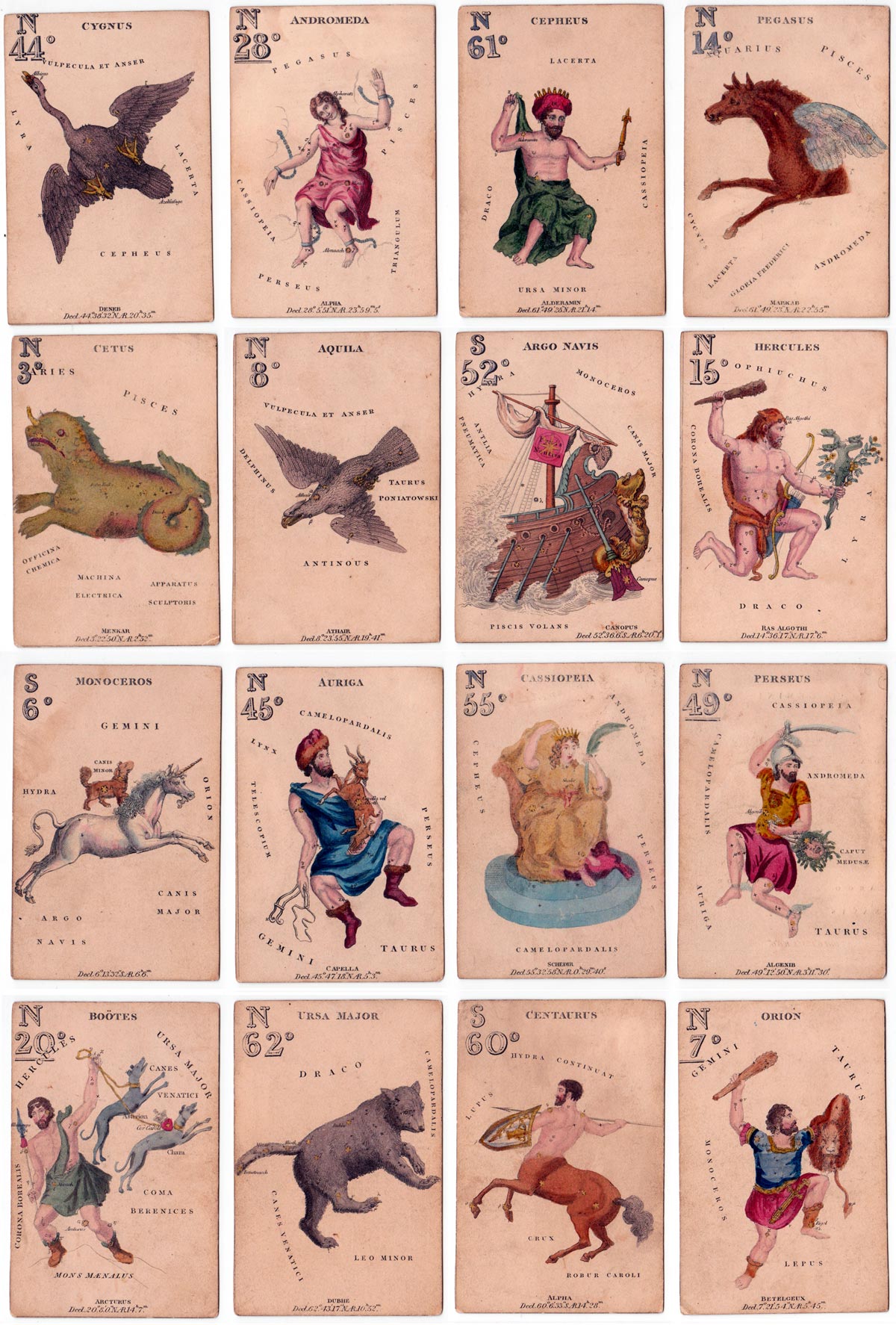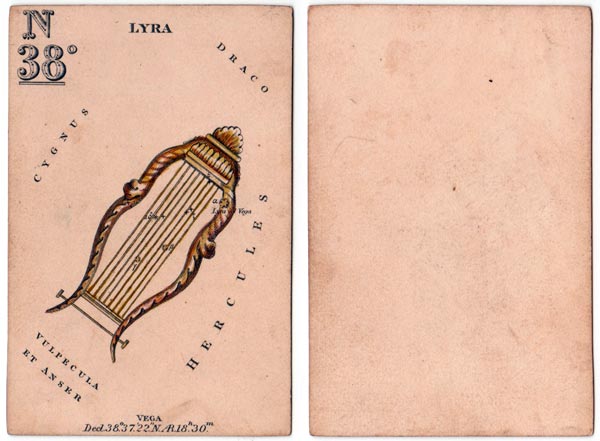Hodges’ Constellations
Hodges’ pack dealing with astronomy had numeral cards carrying diagrams of constellations and their pictorial representations.
Charles Hodges’ Constellation cards, 1828
Hodges’ pack dealing with astronomy, the ‘Astrophilogeon’, was first published around 1828 in conjunction with a series of map cards. These astrological cards carried diagrams of constellations and their pictorial representations. These include the twelve Zodiac signs which is the name given to that part of the sky through which the sun travels during the year:
The Ram, the Bull, the Heavenly Twins,
And next the Crab, the Lion shines -
The Virgin and the Scales,
The Scorpion, Archer, and the Goat,
The Man that Bears the Watering Pot,
And Fish with glittering tails.
Apart from the 12 Zodiac signs, or constellations, the rest of the cards depict other constellations which are given the shapes of gods or godesses, ancient heroes or heroines, beasts and birds, all playing their part in the great heavenly drama. On dark nights, perhaps while guarding the sheep from the wolves, the Greek father would teach his son the names of the constellations and their positions. Each one had a story. The Swan and the winged horse are flying an eternal race, while Andromeda struggles with her chains...


Above: Hodges' astronomy cards showed diagrams of constellations and their pictorial representations. Images courtesy Rex Pitts.
The Zodiac was established about 2000 B.C. by the Babylonians. It was adopted by the Greeks and regarded with superstitious awe. The various movements of the sun, moon and planets formed the basis upon which astrologers cast horoscopes.
These Constellation cards were published in conjunction with map cards, and the object of the game was to obtain pairs of map and constellation cards from similar parts of the terrestrial and celestial globes.

By Rex Pitts (1940-2021)
Member since January 30, 2009
Rex's main interest was in card games, because, he said, they were cheap and easy to get hold of in his early days of collecting. He is well known for his extensive knowledge of Pepys games and his book is on the bookshelves of many.
His other interest was non-standard playing cards. He also had collections of sheet music, music CDs, models of London buses, London Transport timetables and maps and other objects that intrigued him.
Rex had a chequered career at school. He was expelled twice, on one occasion for smoking! Despite this he trained as a radio engineer and worked for the BBC in the World Service.
Later he moved into sales and worked for a firm that made all kinds of packaging, a job he enjoyed until his retirement. He became an expert on boxes and would always investigate those that held his cards. He could always recognize a box made for Pepys, which were the same as those of Alf Cooke’s Universal Playing Card Company, who printed the card games. This interest changed into an ability to make and mend boxes, which he did with great dexterity. He loved this kind of handicraft work.
His dexterity of hand and eye soon led to his making card games of his own design. He spent hours and hours carefully cutting them out and colouring them by hand.
Related Articles

Scientific Whist
“Scientific Whist” : standard cards with instructions for play on the faces by Chas Goodall & Son, 1...

Agent Provocateur
Branded lingerie collection in a pack of pin-up playing cards.

Nimbus playing cards
Mike Steer’s weather-themed pack with suits in four colours and backs for cardistry.

Agatha Christie and Playing Cards revisited
Agatha Christie uses card-play as a primary focus of a story, and as a way of creating plots and mot...

The Decadent Deck
Studies in the eroticism of the female body by Inge Clayton.

Historic Shakespeare
“Historic Shakespeare” playing cards featuring Shakespearean characters by Chas Goodall & Son.

Copechat Paramount Sorting System
Preserving the past: a specimen deck showcasing edge-notched cards and their ingenious sorting syste...

Heartsette by Herbert Fitch & Co, 1893
A glimpse into a busy print and design office in late Victorian London.

German Travel Cards
A travel-themed educational deck helping American tourists visiting Germany.

Batman® playing cards
Batman playing cards published by InterCol of London 1989.

Can You Believe Your Eyes?
“Can You Believe Your Eyes?” playing cards featuring visual illusions & other oddities.

Pastime Playing Cards for the Blind
The “Pastime” Playing Cards for the Blind manufactured by Goodall & Son Limd., c.1910.

Songs with Flute accompaniment
Eighteenth century English engraved cards with music for voice and flute.

Love Tests
Vintage novelty “Love Test” cards of a slightly saucy nature but all in good fun!

The Game of the Gods
Figures and symbols from Norse mythology, designed by Barbro Gustafsson and Inga Lundström.

Ben 10 playing cards
Characters from the American animated television science fantasy series Ben 10.
Most Popular
Our top articles from the past 28 days




